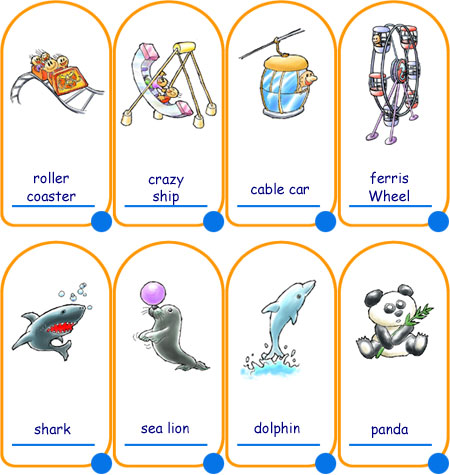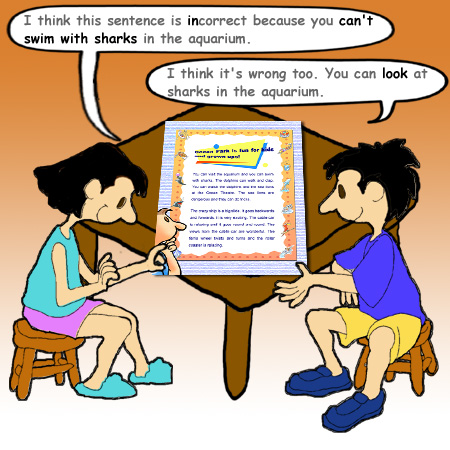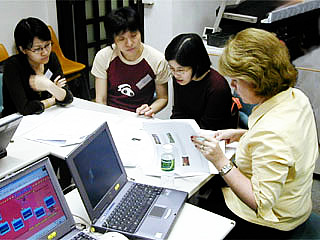| 1. |
Theory: |
The purpose of this activity is to arouse
students' interest and encourage communication. Short answers are
acceptable and it is not appropriate to insist on grammatical accuracy at
this stage. Avoid correcting students while
they are speaking because it may discourage them from contributing to the discussion.
It
is a good idea to repeat what individuals say so that the whole class can
hear individual contributions. When repeating, you can model the students
ideas in grammatically correct sentences without directly drawing attention
to the errors they made. If students express their ideas in Cantonese,
model them in English for the whole class.
|
| 2. |
Example: |
 |
cable car |
 |
panda |
 |
crazy ship |
 |
roller coaster |
 |
dolphin |
 |
sea lion |
 |
ferris wheel |
 |
shark
|
|
| 2. |
Theory: |
It is important to give
students a clear model of the target language. They need to be able to
hear the vocabulary with correct syllable stress and clear pronunciation
before they go on to practise saying it.
|
| 4. |
Key: |

|
| 5. |
Example: |
 |
can clap |
 |
can swim |
 |
friendly |
 |
can dive |
 |
can walk |
 |
funny |
 |
can jump |
 |
dangerous |
 |
rises and falls |
 |
can kill |
 |
exciting |
 |
backwards and forwards
|
|
| 5. |
Example: |
 |
sharks - can dive - can swim - can
kill - dangerous
|
|
| 6. |
Theory: |
Monitoring helps
the teacher to identify problems that need to be dealt with on an
individual basis. It also enables the teacher to make a note of problems
that are common to many students. These problems can then be focused on
during whole-class feedback.
|
| 7. |
Key: |
Here are some possible answers:
 |
sharks - can dive - can swim - can
kill - dangerous |
 |
sea lions - can clap - can swim -
can walk |
 |
dolphins - can dive - can swim -
can jump - friendly |
 |
pandas - friendly |
 |
roller coaster - exciting |
 |
crazy ship - backwards and
forwards - exciting |
 |
cable car - rises and falls |
 |
ferris wheel - exciting
|
|
| 8. |
Example: |
| sharks |
They can swim.
They can dive.
They can kill.
|
They are dangerous. |
| sealions |
They can clap.
They can swim.
They can walk.
|
They are funny. |
| dolphins |
They can dive.
They can swim.
They can jump.
|
|
| pandas |
They are friendly.
|
|
| roller coaster |
It is exciting.
|
|
| crazy ship |
It is exciting.
|
It goes backwards and forwards. |
| cable car |
It rises and falls.
|
|
| ferris wheel |
It is exciting.
|
|
|
| 8. |
Note: |
It is
important to present vocabulary and grammar in an organised way on the
board so that students can see how it is used in context. Grammatical
features, such as verbs, adjectives and adverb groups, can be highlighted
to help students to become aware of the grammatical patterns that occur in
English.
It is not always necessary to go
into grammatical explanations with KS2 students. If students are
encouraged to notice patterns and work things out for themselves they can
start to form their own rules and this can help make the target language more
meaningful and memorable.
|
| 8. |
Theory: |
Getting
willing students to write on the board has a number of benefits for
language learners:
 |
It
enables students to be actively involved in the presentation and
feedback of the target language. |
 |
It
can give students a sense of responsibility. |
 |
It
can provide students with an opportunity to demonstrate what they
already know and thereby increase their confidence in using
English. |
 |
It
can add variety and provide a change of pace in the lesson. |
 |
It
allows the teacher to identify problems which can then be dealt
with before students move onto the next activity.
|
|
| 9. |
Example:
|
 |
They can kill |
 |
They are dangerous
|
|
| 9. |
Theory: |
Students need to be able to distinguish between
essential key words which carry meanings, and words which can be
ignored for note-making purposes. Activities are provided in which students
expand and contract sentences to help raise their awareness of the kinds
of word classes that carry information essential for making notes. In
the activities in this package, verbs, adjectives and adverb
groups carry meanings. Students need to be able to spot the key words and
transfer them from sentences for the purpose of
making notes. (Nouns are already provided in the note making
worksheets).
|
| 11. |
Theory: |
When we scan,
we read quickly to find specific information within a text. We
already have an idea of the kind of information we are looking for so it is not necessary to read and understand every word.
|
| 11. |
Note: |
Steps 8 -10 contain highly structured
activities which prepare students for the reading text. The reading text
contains some unfamiliar and difficult vocabulary, however students do not
need to be able to understand everything in the text. The preparatory
activities ensure that students have a purpose for reading and can tackle
difficult texts and obtain the information they are looking for.
|
| 12. |
Key: |
Animals
| Attractions |
What can they do? |
What are they like? |
What can you see/do/visit? |
| sharks |
kill
|
dangerous
|
 |
visit shark aquarium |
 |
see 70 sharks |
 |
walk through underwater tunnel |
|
| dolphins |
jump
dive
somersault
|
intelligent
|
 |
visit Dolphin University |
 |
learn about caring for marine animals |
|
| sealions |
do tricks
clap
walk
|
adorable
amusing
funny
|
 |
visit Ocean Theatre |
|
| pandas |
|
14 years old
95kg
friendly
|
 |
learn about an endangered animal |
 |
learn how to save pandas from extinction |
|
Rides
| Attractions |
What does it do? |
What is it like? |
What can you do? |
| roller coaster |
twists
turns
loops
|
very exciting
|
 |
enjoy Hong Kong's longest roller coaster |
|
| crazy swing |
goes backwards and forwards
swings high and low
|
exciting
a huge swing
|
 |
scream your head off |
|
| cable car |
rises and falls
|
fascinating
wonderful
breathtaking
|
 |
see all of Ocean Park |
 |
see the South China Sea |
|
| ferris wheel |
goes round and round
|
relaxing
fun
27 metres tall
|
 |
ride on the ferris wheel with all of the family |
|
|
| 12. |
Adaptation:
|
Steps 8-10 contain highly structured activities
that prepare students for the reading activity and ensure that students bring knowledge to the semi-authentic text in the
Information sheet. However, depending on the ability and confidence of
your class you could adapt Steps 8-12 in the following ways:
 |
For less confident students, or if you feel that
your
students need more guidance, work through Steps 8-10 as indicated, in Step
11 give them
the worksheet entitled Information sheet (highlighted) which has the key
information highlighted in bold. Ask them to put the bolded information into the correct boxes in
the Animals and Rides worksheets.
|
 |
For more confident
students who are already familiar with the grammatical focus of this
package, or for students who do not require such highly structured
activities and are confident meeting unfamiliar vocabulary, you can miss out Steps 8-10.
Ask students to use their own ideas along with the information sheet in
order to complete the tables in the Rides and Animals worksheets.
|
 |
This adaptation is for more confident students
who are already familiar with terms such as adverb, adjective
and verb.
If your students are already familiar with the
labels used for word classes (ie verbs, adverbs, adjectives) you
can give them the Reading race instructions
in order to find information in the Information
sheet. They can use the information obtained through the
reading race in order to complete the Rides and Animals worksheets.
How to carry out the Reading race:
| 1. |
Put students into groups of four. |
| 2. |
Explain that you have a set of instructions for each group on pieces of paper on your desk. |
| 3. |
Appoint a team leader in each group who must come to your desk and ask for
an instruction which they have to take back to their group and read out to
the group. |
| 4. |
The other students in the group should scan the Information sheet, find
the answer and write it in note-form in the table on the Rides or Animals
worksheet. |
| 5. |
The team leader then returns to the teachers desk, tells her/him the answer and
collects the next instruction. |
| 6. |
Explain that the race continues until one group has found all the
information. |
| 7. |
The teacher then feeds back the answers
with the whole class.
|
|
Note:
The reading race can give students the
opportunity to practise reading, speaking, listening and writing skills
through an enjoyable activity. However, good organisation and classroom
management skills are important in order to maximise purposeful talk and
minimise unnecessary noise.
Make sure that every group is clear about
individual responsibilities and that individuals are given a
responsibility that they are capable of carrying out confidently. You will
need to ensure that each group has someone who is responsible for the
following: collecting the
instruction and reading it out; looking for the answer in the text;
writing the answer; returning to the teachers' desk to say the
answer and collect the next instruction.
|
| 13. |
Theory:
|
The process of reviewing and making changes to
a piece of writing is known as editing.
In the editing process, writers review and change content before
proofreading it to check for accuracy of grammar, punctuation and
spelling.
Students need activities to help them develop their editing skills if they
are to become independent and effective editors of their own work. The
editing activity in this package encourages students to focus on the
accuracy of the information about the attractions at Ocean Park.
|
| 14. |
Theory: |
There are a number of reasons for getting
students to check their ideas/answers with a partner in this
activity:
 |
It gives students the
opportunity to recycle the vocabulary and grammar they have
learned and use it for a communicative purpose. |
 |
It is a good way of getting
students to develop and use the communicative functions that
are associated with the targets in the Interpersonal
Dimension of TOC. |
 |
It encourages students to
develop and use the language they need to participate in
collaborative learning.
|
|
| 14. |
Example: |
In order to compare answers/ideas, students
need to be able to ask questions and seek agreement. It is a good idea to
build up a display of such language in the classroom in order to encourage
students to use it during group and pair work.

|
| 16. |
Key: |
The incorrect information is highlighted in
italics:
Ocean Park is fun for kids!
You can visit the aquarium and you can swim with sharks. The
dolphins can walk and clap. You can
watch the dolphins and the sea lions at the Ocean Theatre. The sea lions
are dangerous and they can do tricks. The
crazy ship is a big slide.
It goes backwards and forwards. It is very exciting. The cable car is
relaxing and it goes round and round. The views from the cable car
are wonderful. The ferris wheel twists and turns
and the roller
coaster is relaxing. |
The corrections are in bold:
|
Ocean Park is fun for kids!
You can visit the aquarium and you can look at the sharks. The
dolphins can jump, swim and dive.
You can watch the dolphins and the sea lions at the Ocean Theatre. The sea
lions are funny/amusing and they can do tricks. The crazy ship is a
big swing. It goes backwards and forwards. It is very exciting. The
cable car is relaxing and it goes up and down. The views from the
cable car are wonderful. The ferris wheel goes round and round and
the roller coaster is exciting/scary/frightening.
|
|



